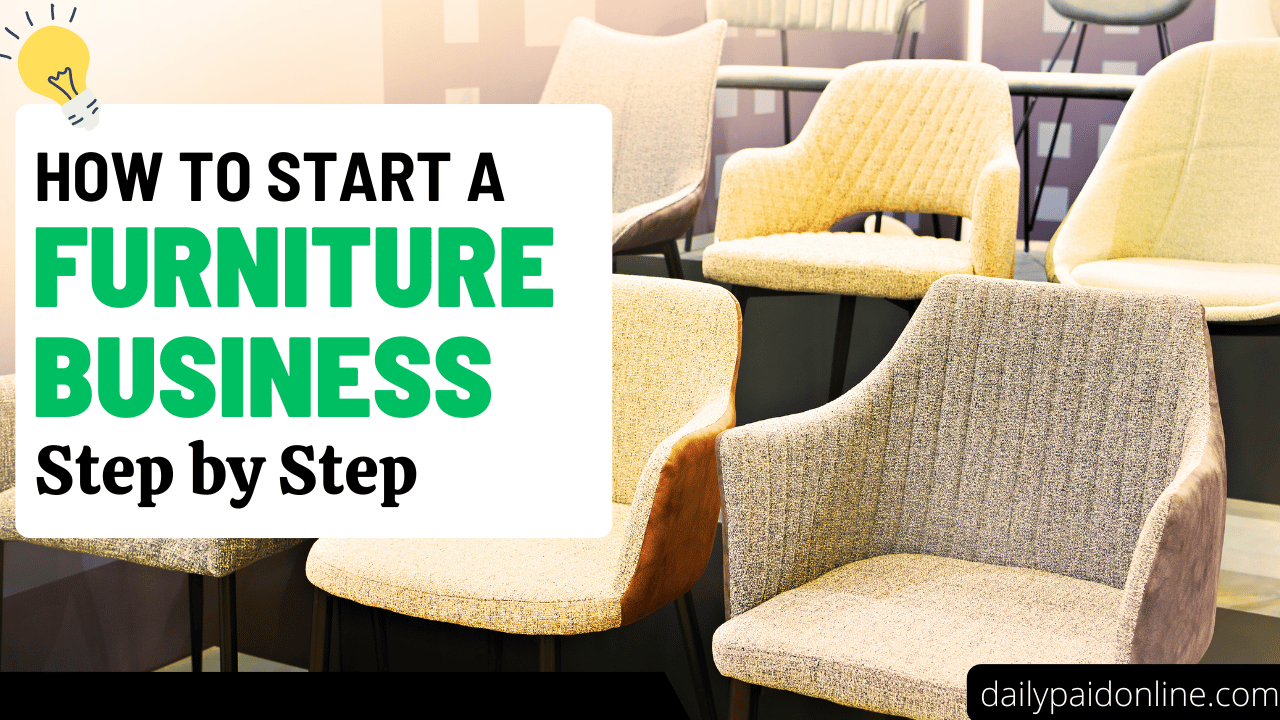The information provided in this blog post is for general informational and educational purposes only. It may contain affiliate links. If you make a purchase using one of these links, we may receive compensation at no extra cost to you. This will help us to maintain the website. Please read our disclosure policy for more information.
Disclaimer: The information provided in this article is for educational and informational purposes only. Starting a business involves financial risks and legal considerations that vary by location. Always consult with qualified professionals, including business advisors, accountants, and attorneys, before making any business decisions. Results may vary based on individual circumstances, market conditions, and execution of business strategies.
Starting a furniture business can be a rewarding experience for entrepreneurs who love home décor and craftsmanship. The global furniture market is growing. There is a rising demand for both traditional and new furniture styles. Whether you want to make, sell, or design furniture, this guide will help you with each step to start your successful furniture business.
Understanding the Furniture Industry Landscape
The furniture industry includes various types of businesses, from small workshops to large factories. Before starting your furniture business, it’s important to know the market, current trends, and available opportunities. The industry covers residential furniture, commercial furniture, outdoor furniture, and special areas like children’s furniture and eco-friendly options.
Recently, many consumers are interested in sustainable materials, customizable designs, and multifunctional furniture. E-commerce has also changed how furniture businesses operate, making online sales more important alongside traditional showrooms.
Step 1: Define Your Furniture Business Niche
Identifying your specific niche is fundamental to building a successful furniture business. Consider these popular furniture business types:
Manufacturing Business: Creating furniture from raw materials requires significant investment in equipment, workspace, and skilled labor. This model offers complete control over quality and design but demands substantial capital and expertise.
Retail Business: Selling furniture from various manufacturers allows you to offer diverse products without manufacturing complexities. This model requires less technical expertise but needs strong supplier relationships and inventory management skills.
Custom Design Services: Offering bespoke furniture design and creation services caters to clients seeking unique pieces. This model typically commands higher prices but requires exceptional craftsmanship and design skills.
Online Furniture Store: E-commerce furniture businesses can operate with lower overhead costs and reach broader markets. However, they face challenges with shipping logistics and customer inability to physically examine products.
Furniture Restoration: Specializing in refurbishing and restoring vintage or damaged furniture appeals to environmentally conscious consumers and those seeking unique pieces at lower prices.
Step 2: Conduct Comprehensive Market Research
Good market research is essential for your business strategy. Start by analyzing your target market’s demographics, such as age, income, lifestyle, and buying habits. Look at your competitors to learn about their pricing, products, marketing, and customer service.
Check local market conditions, like population growth, housing trends, and economic factors. Find gaps in the market where your furniture business can stand out. Use online tools, industry reports, and customer surveys to gain insights into market demand and preferences.
Step 3: Develop a Solid Business Plan
A well-crafted business plan serves as your roadmap to success. Your furniture business plan should include:
Executive Summary: Concise overview of your business concept, target market, and unique value proposition.
Market Analysis: Detailed research findings about your industry, target customers, and competitive landscape.
Products and Services: Comprehensive description of your furniture offerings, including materials, styles, and price ranges.
Marketing Strategy: Detailed plans for reaching and attracting customers through various channels.
Operations Plan: Logistics of running your business, including suppliers, production processes, and delivery methods.
Financial Projections: Realistic estimates of startup costs, operating expenses, revenue forecasts, and break-even analysis.
Step 4: Secure Funding for Your Furniture Business
Starting a furniture business needs a lot of money to begin. First, calculate your startup costs, which should include:
- Workspace rental or purchase
- Equipment and tools
- Initial inventory or raw materials
- Business licenses and permits
- Insurance coverage
- Marketing and branding expenses
- Working capital for operations
Explore various funding options such as personal savings, bank loans, SBA loans, angel investors, crowdfunding platforms, or partnerships. Prepare a compelling pitch highlighting your business potential and demonstrating how you’ll generate returns on investment.
Step 5: Handle Legal Requirements and Registration
Starting your furniture business legally protects your personal assets and helps you follow the rules. Here are the key legal steps to take:
Choose a Business Structure: Select between sole proprietorship, partnership, LLC, or corporation based on liability protection needs and tax implications.
Register Your Business Name: Ensure your chosen name is available and register it with the appropriate state authorities.
Obtain Necessary Licenses: Research and acquire required business licenses, permits, and certifications specific to furniture businesses in your area.
Get Insurance Coverage: Protect your business with general liability insurance, product liability coverage, and property insurance.
Set Up Tax Accounts: Register for federal and state tax identification numbers and understand your tax obligations.
Step 6: Establish Your Supply Chain and Operations
Building strong relationships with suppliers is essential for success in the furniture business. First, research and check potential suppliers for their quality, reliability, pricing, and delivery terms. It’s important to develop connections with multiple suppliers to keep your business running smoothly.
Set up efficient operational processes, including:
Inventory Management: Implement systems to track materials, work-in-progress, and finished goods.
Quality Control: Establish standards and procedures to ensure consistent product quality.
Production Workflow: Design efficient processes from order receipt to delivery.
Workspace Organization: Optimize your facility layout for productivity and safety.
Step 7: Create Your Brand and Marketing Strategy
Strong branding differentiates your furniture business in a competitive market. Develop a memorable brand identity including:
- Compelling brand story and values
- Professional logo and visual identity
- Consistent brand messaging
- High-quality product photography
- Engaging website design
Implement a multi-channel marketing strategy combining:
Digital Marketing: SEO-optimized website, social media presence, email marketing, and online advertising.
Traditional Marketing: Print advertisements, trade shows, showroom displays, and networking events.
Content Marketing: Blog posts, design guides, and video content showcasing your expertise and products.
Customer Referrals: Incentivize satisfied customers to recommend your business.
Step 8: Launch Your Furniture Business
After finishing your preparations, start your launch plan. Begin with a soft launch to test how things work and collect feedback before the full launch. Think about hosting a grand opening event to create excitement and draw in your first customers.
Make sure to provide great customer experiences from day one. Train your staff well, set up smooth order processes, and quickly respond to customer questions and issues.
Step 9: Scale and Grow Your Business
After establishing your furniture business foundation, focus on sustainable growth strategies:
Expand Product Lines: Introduce new furniture styles or categories based on customer demand.
Enter New Markets: Explore geographical expansion or new customer segments.
Develop Partnerships: Collaborate with interior designers, real estate developers, or complementary businesses.
Enhance Online Presence: Invest in e-commerce capabilities and digital marketing to reach broader audiences.
Improve Operations: Continuously optimize processes for efficiency and profitability.
Conclusion
Starting a furniture business requires careful planning, a good amount of money, and a focus on quality and customer satisfaction. By following this guide, you’ll be ready to face the challenges and take advantage of the opportunities in the furniture industry. Remember, success takes time and requires persistence, flexibility, and ongoing learning.
Build strong relationships with your customers and suppliers. Keep high-quality standards and pay attention to market trends. With a passion for furniture and a commitment to doing well, your furniture business can succeed in this exciting industry. Take the first step today to turn your furniture business dreams into reality.

